The Eurasian Idea
Primary tabs
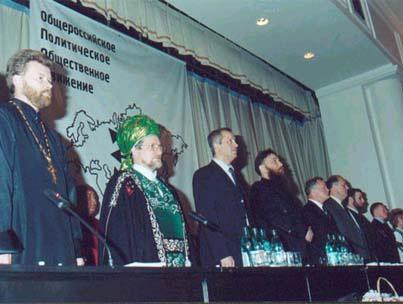
The Eurasian Idea
What is Eurasianism today? What forms the concept of Eurasia? -- Seven senses of word Eurasianism -- Evolution of notion of Eurasianism
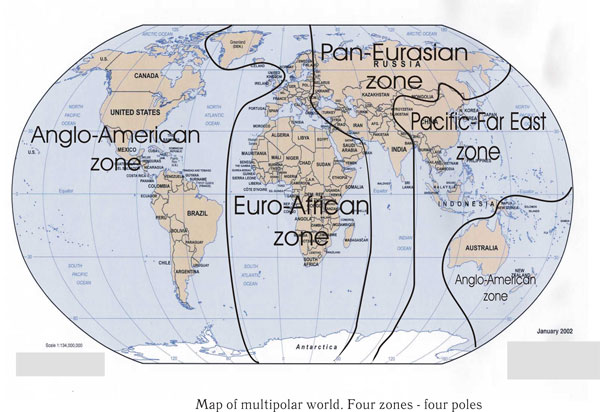
Changes in the original meaning of Eurasianism
Different terms lose their original meaning though their daily use over the course of many years. Such fundamental notions as socialism, capitalism, democracy, fascism have changed profoundly. In fact, they have turned banal.
The terms "Eurasianism" and "Eurasia" also have some uncertainties because they are new, they belong to a new political language and intellectual context that is only being created today.
The Eurasian Idea mirrors a very active dynamical process. It's meaning has become clearer throughout history but needs to be further developed.
Eurasianism as a philosophical struggle
The Eurasian Idea represents a fundamental revision of the political, ideological, ethnic, and religious history of mankind, and it offers a new system of classification and categories that will overcome standard cliches. The Eurasian theory went through two stages - a formational period of classical Eurasianism at the beginning of the XX century by Russian emigrant intellectuals (Trubeckoy, Savickiy, Alekseev, Suvchinckiy, Iljin, Bromberg, Hara-Davan etc.) followed by the historical works of Leonid Gumilev and, finally, the constitution of neo-Eurasianism (second half of 1980's to the present).
Towards neo-Eurasianism
Classical Eurasian theory undoubtedly belongs to past and can be correctly classified within the framework of ideologies of the XX century. Classical Eurasianism might have passed, but neo-Eurasianism has given it a second birth, a new sense, scale, and meaning. When the Eurasian Idea arose from its ashes, it became less obvious, but has since revealed its hidden potential.
Through neo-Eurasianism, the entire Eurasian theory has received a new dimension. Today we cannot ignore the large historical period of neo-Eurasianism and must try to comprehend it in its modern context. Furthermore, we will describe the various aspects of this notion.
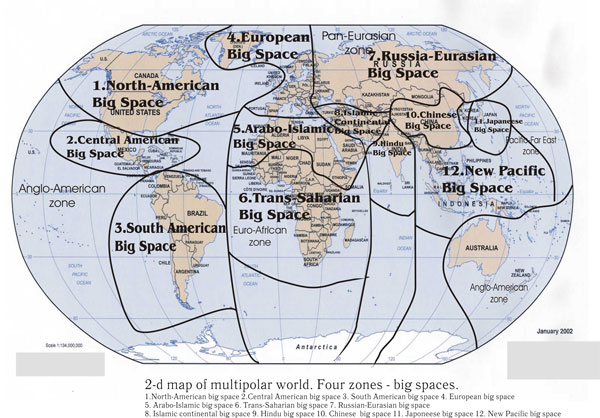
Eurasianism as a global trend
Globalization as the main body of modern history
In the broad sense, the Eurasian Idea and even Eurasia as concept do not strictly correspond to the geographical boundaries of the Eurasian continent. The Eurasian Idea is a global-scale strategy that acknowledges the objectivity of globalization and the termination of "nation-states" (Etats-Nations), but at the same time offers a different scenario of globalization, which entails no unipolar world or united global government. Instead, it offers several global zones (poles). The Eurasian Idea is an alternative or multipolar version of globalization, but globalization is the currently the major fundamental world process that is deciding the main vector of modern history.
Paradigm of globalization - paradigm of Atlantism
Today’s nation-state is being transformed into a global state; we are facing the constitution of planetary governmental systems within a single administrative-economic system. To believe that all nations, social classes, and economic models might suddenly begin to cooperate on the basis of this new planet-wide logic is wrong. Globalization is a one-dimensional, one-vector phenomenon that tries to universalize the Western (Anglo-Saxon, American) point of view of how to best manage human history. It is (very often connected with suppression and violence) the unification of different social-political, ethnic, religious, and national structures into one system. It is a Western European historical trend that has reached its peak through its domination of the United States of America.
Globalization is the imposing of the Atlantic paradigm. Globalization as Atlantism absolutely tries to avoid this definition. Proponents of globalization argue that when there will be no alternative to Atlantism and that it will stop being Atlantism. The American political philosopher F. Fukuyama writes about the "end of History," which actually means the end of geopolitical history and the conflict between Atlantism and Eurasianism. This means a new architecture of a world system with no opposition and with only one pole - the pole of Atlantism. We may also refer to this as the New World Order. The model of opposition between two poles (East-West, North-South) transforms to the center-outskirt model (center - West, "rich North," outskirt - South). This variant of world architecture is completely at odds with the concept of Eurasianism.
Unipolar globalization has an alternative
Today the New World Order is nothing more than a project, plan, or trend. It is very serious, but it is not fatal. Adherents of globalization deny any alternative plan for future, but today we are experiencing a large-scale phenomenon - contra-globalism, and the Eurasian Idea coordinates all opponents of unipolar globalization in a constructive way. Moreover, it offers the competing idea of multipolar globalization (or alter-globalization).
Eurasianism as pluriversum
Eurasianism rejects the center-outskirt model of the world. Instead, the Eurasian Idea suggests that the planet consists of a constellation of autonomous living spaces partially open to each other. These areas are not national-states, but a coalition of states, reorganized into continental federations or "democratic empires" with a large degree of inner self-government. Each of these areas is multipolar, including a complicated system of ethnic, cultural, religious and administrative factors.
In this global sense, Eurasianism is open to everyone, regardless of one’s place of birth, residence, nationality or citizenship. Eurasianism provides an opportunity to choose a future different from the cliche of Atlantism and one value system for all of mankind. Eurasianism does not merely seek the past or to preserve the current status quo, but strives for the future,acknowledging that the world’s current structure needs radical change, that nation states and industrial society have exhausted all their resources. The Eurasian Idea does not see the creation of a world government on the basis of liberal-democratic values as the one and only path for mankind. In its most basic sense, Eurasianism in the XXI century is defined as the adherence to alter-globalization, synonymous with a multipolar world.
Atlantism is not universal
Eurasianism absolutely rejects the universalism of Atlantism and Americanism. The pattern of Western-Europe and America has many attractive features that can be adopted and praised, but, as a whole, it is merely a cultural system that has the right to exist in its own historical context along with other civilizations and cultural systems.
The Eurasian Idea protects not only anti-Atlantic value systems, but the diversity of value structures. It is a kind of "poliversum" that provides living space for everyone, including the USA and Atlantism, along with other civilizations, because Eurasianism also defends the civilizations of Africa, both American continents, and the Pacific area parallel to the Eurasian Motherland.
The Eurasian Idea promotes a global revolutionary idea
The Eurasian Idea on a global scale is a global revolutionary concept, called upon to be a new platform for mutual understanding and cooperation for a large conglomerate of different powers: states, nations, cultures, and religions that reject the Atlantic version of globalization.
If we analyze the declarations and statements of various politicians, philosophers, and intellectuals we will see that majority of them are adherents (sometimes unaware) of the Eurasian Idea.
If we will think about all of those who disagree with the "end of history" our spirits will be raised and the failure of the American concept of strategic security for the XXI century connected with constituting the unipolar world will be much more realistic.
Eurasianism is the sum of the natural, artificial, objective, and subjective obstacles on the path of unipolar globalization; it offers a constructive, positive opposition to globalism instead of simple negation.
These obstacles, however, remain uncoordinated in the meantime, and proponents of Atlantism are able to manage them easily. Yet, if these obstacles can somehow be integrated into a united force, they will be can be integrated into something united and the likelihood of victory will become much more serious.
Eurasianism as the Old World (continent)
The New World is a part of the Second Old World or a more specific and narrow sense of the word Eurasianism applicable to what we call the Old World. The Notion of the Old World (traditionally regarding Europe) can be considered in a much wider context. It is multi-civilizational super space, inhabited by nations, states, cultures, ethnicities, and religions connected to each other historically and geographically by dialectic destiny. The Old World is an organic product of human history.
The Old World is often opposed to the New World, the American continent, discovered by Europeans and transformed into a platform for an artificial civilization, where European projects of modernism were created. It was built based upon human-produced ideologies as a purified civilization of modernism.
The United States was the successful creation of the "perfect society," formed by intellectuals from England, Ireland, and France, while the countries of South and Central America remained colonies of the Old World. Germany and Eastern Europe were less influenced this idea of a “perfect society.»
In the terms of Oswald Spengler, dualism between the Old and New World can be brought to opposites: culture-civilization, organic-artificial, historical-technical.
The New World as Messiah
As a historical product of Western Europe during its evolution, the New World very early on realized its "messiah" destiny, where the liberal-democratic ideals of the Enlightment were combined with the eschatological ideas of radical protestant sects. This was called the theory of Manifest Destiny, which became the new symbol of belief for generations of Americans. According to this theory, American civilization overtook all cultures and civilizations of the Old World and in its current universal form, it is obligatory for all nations of the planet.
With time, this theory directly confronted, not only the cultures of the East and Asia, but came into conflict with Europe, which seemed to the Americans to be archaic and full of prejudice and antiquated traditions.
In turn, the New World turned away from the heritage of the Old World. Directly following WWII, the New World became the indisputable leader in Europe itself with the "criteria of verity" of others. This inspired a corresponding wave of American dominance and at a parallel time the beginning of a movement that seeks geopolitical liberation from the brutal, transoceanic, strategic, economic, and political control of the "elder Brother.»
Integration of the Eurasian continent
In the XX century, Europe became aware of its common identity and step by step started to move towards the integration of all its nation into a common union, able to guarantee full sovereignty, security, and freedom to itself and all members.
The creation of the European Union became the most important event that helped Europe restore its status as a world power alongside the United States of America. This was the response of the Old World to the excessive challenge of the New World.
If we consider the alliance of the USA and Western Europe as the Atlantic vector of European development, European integration under the aegis of the continental countries (Germany, France) may be called European Eurasianism. This becomes more and more obvious if we take into consideration the theory of Europe from the Atlantic Ocean to the Urals (S. de Goll) or even to Vladivostok. In other words, the integration of the Old World includes the vast territory of Russian Federation.
Thus, Eurasianism in this context may be defined as a project of the strategic, geopolitical, and economic integration of the north of Eurasian continent, considered the cradle of European history and the matrix of European nations.
Parallel with Turkey, Russia (alike ancestors of the Europeans) is historically connected with the Turkic, Mongolian, and Caucasus nations. Russia gives the integration of Europe an Eurasian dimension in both the symbolic and geographic senses (identification of Eurasianism with continentalism).
During last few centuries, the idea of European integration has been proposed by the revolutionary faction of European elites. In ancient times, similar attempts were made by Alexander the Great (integration of the Eurasian continent) and Genghis khan (founder of history’s largest empire).
Eurasia as three great living-spaces, integrated across the meridian
Three Eurasian belts (meridian zones)
The horizontal vector of integration is followed by a vertical vector.
Eurasian plans for the future presume the division of the planet into four vertical geographical belts (meridian zones) from North to South.
Both American continents will form one common space oriented on and controlled by the USA within the framework of the Monroe Doctrine. This is the Atlantic meridian zone.
In addition to the above zone, three others are planned. They are the following:
· Euro-Africa, with the European Union as its center;
· Russian-Central Asian zone;
· Pacific zone
Within these zones, the regional division of labor and the creation of developmental areas and corridors of growth will take place.
Each of these belts (meridian zones) counterbalance each other and all of them together counterbalance the Atlantic meridian zone. In the future, these belts might be the foundation upon which to build a multipolar world: the number of poles will be more than two; however, the number will be much less than the number of current nation-states. The Eurasian model proposes that the number of poles must be four.
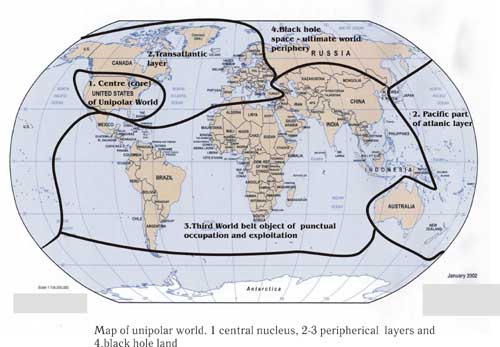
Great spaces
The Meridian zones in the Eurasian project consist of several "Great Spaces" or "democratic empires." Each possesses relative freedom and independence but is strategically integrated into a corresponding meridian zone.
The Great Spaces correspond to the boundaries of civilizations and include several nation-states or unions of states.
The European Union and Arab Great Space, which integrates North, Trans-Saharan Africa and the Middle East, form Euro-Africa.
The Russian-Central Asian zone is formed by three Great Spaces that sometimes overlap each other. The first is the Russian Federation along with several countries of the CIS - members of the Eurasian Union. Second is the Great Space of continental Islam (Turkey, Iran, Afghanistan, Pakistan). The Asian countries of the CIS intersect with this zone.
The third Great Space is Hindustan, which is a self-dependent civilization sector.
The Pacific meridian zone is determined by a condominium of two great spaces (China and Japan) and also includes Indonesia, Malaysia, The Philippines, and Australia (some researchers connect it with the American meridian zone). This geopolitical region is very mosaic and can be differentiated by many criteria.
The American meridian zone consist of the American-Canadian, Central, and North American Great Spaces.
Importance of the fourth zone
The structure of the world based upon meridian zones is accepted by most American geopoliticians who seek the creation of a New World Order and unipolar globalization. However, a stumbling block is the existence of the Russian-Central Asian meridian space: the presence or absence of this belt radically changes the geopolitical picture of the world.
Atlantic futurologists divide the world into the three following zones:
· American pole, with the European Union as its close-range periphery (Euro-Africa as an exemption) and
· the Asian and Pacific regions as its long-range periphery.
· Russia and Central Asia are fractional, but without it as an independent meridian zone, our world is unipolar.
This last meridian zone counterbalances American pressure and provides the European and Pacific zones ability to act like self-dependent civilization poles.
Real multipolar balance, freedom, and the independence of meridian belts,Great Spaces, and nation-states depend upon the successful creation of a forth zone. Moreover, its is not enough to be one pole in a two-pole model of the world: the rapid progress of the United States of America can be counterbalanced only by the synergy of all three meridian zones.
The Eurasian project proposes this four-zone super-project on a geopolitical strategic level.
Eurasianism as Russian-Central Asian integration
Moscow-Teheran axis
Fourth meridian zone - Russian-Asian meridian integration. The central issue of this process is the implementation of a Moscow-Teheran axis. The whole process of integration depends on the successful establishment of a strategic middle and long-term partnership with Iran. Iranian and Russian economic, military, and political potential together will increase the process of the zone integration, making the zone irreversible and autonomous.
The Moscow-Teheran axis will be a basis for further integration. Both Moscow and Iran are self-sufficient powers, able to create their own organizational strategic model of the region.
Eurasian plan for Afghanistan and Pakistan
The integration vector with Iran is vitally important for Russia to gain access to warm-water ports as well as for the political-religious reorganization of Central Asia (Asian countries of CIS, Afghanistan, and Pakistan). Close cooperation with Iran presumes the transformation of
the Afghani-Pakistani area into a free Islamic confederation, loyal both to Moscow and Iran. The reason this is necessary is that the independent states of Afghanistan and Pakistan will be the continuing source of destabilization, threatening neighboring countries. The geopolitical struggle will provide the ability to implement a new Central-Asian federation and transform this complicated region into one of cooperation and prosperity area.
Moscow-Deli axis
Russian-Indian cooperation is the second most important meridian axis in the integration on the Eurasian continent and collective Eurasian security systems. Moscow will play an important role, decreasing the tensions between Deli and Islamabad (Kashmir). The Eurasian plan for India, sponsored by Moscow, is the creation of a federation that will mirror the diversity of Indian society with its numerous ethnic and religious minorities, including Sikhs and Muslims
Moscow-Ankara
The main regional partner in the integration process of Central Asia is Turkey. The Eurasian Idea is already becoming rather popular there today because of Western trends interlaced with Eastern. Turkey acknowledges its civilization differences with the European Union, its regional goals and interests, the threat of globalization, and further loss of sovereignty.
It is strategically imperative for Turkey to establish a strategic partnership with the Russian Federation and Iran. Turkey will be able to maintain its traditions only within the framework of a multipolar world. Certain factions of Turkish society understand this situation - from politicians and socialists to religious and military elites. Thus, the Moscow-Ankara axis can become geopolitical reality despite a long-term period of mutual estrangement.
Caucasus
The Caucasus is the most problematic region to Eurasian integration because its mosaic of cultures and ethnicities easily leads to tensions between nations. This is one of main weapons used by those who seek to stop integration processes across Eurasian continent. The Caucasus region is inhabited by nations belonging to different states and civilization areas. This region must be a polygon for testing different methods of cooperation between peoples, because what can succeed there
can succeed across the Eurasian continent. The Eurasian solution to this problem lies not in the creation of ethnic-based states or assigning one nation strictly to one state, but in the development of a flexible federation on the basis of ethnic and cultural differences within the common strategic context of the meridian zone.
The result of this plan is a system of a half-axis between Moscow and the Caucasian centers, (Moscow-Baku, Moscow-Erevan, Moscow-Tbilissi, Moscow-Mahachkala, Moscow-Grozny, etc.) and between the Caucasian centers and Russia's allies within the Eurasian project (Baku-Ankara, Erevan-Teheran etc.).
Eurasian plan for Central Asia
Central Asia must move towards integration into a united, strategic, and economic block with the Russian Federation within the framework of the Eurasian Union, the successor of the CIS. The main function of this specific area is the rapprochement of Russia with the countries of continental Islam (Iran, Pakistan, Afghanistan).
From the very beginning, the Central-Asian sector must have various vectors of integration. One plan will make the Russian Federation the main partner (similarities of culture, economic and energetic interests, a common strategic security system). The alternate plan is to place the accent on ethnic and religious resemblance: Turkic, Iranian, and Islamic worlds.
Eurasian integration of post-soviet territories
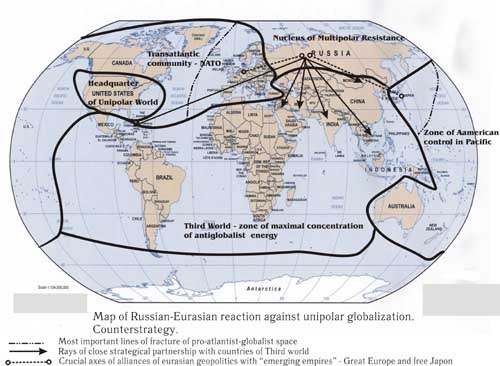
Eurasian Union
A more specific meaning of Eurasianism, partially similar to the definitions of the Eurasian intellectuals of 20-30s of the XX century is connected with the process of the local integration of post-soviet territories.
Different forms of similar integration can be seen in history: from the Huns and other (Mongol, Turkic, and Indo-European) nomad empires to the empire of Genghis khan and his successors. More recent integration was led by the Russian Romanov Empire and, later, the USSR. Today, the Eurasian Union is continuing these traditions of integration through a unique ideological model that takes into consideration democratic procedures; respects the rights of nations; and pays attention to the cultural, lingual, and ethnic features of all union members.
Eurasianism is the philosophy of integration of the post-Soviet territory on a democratic, non-violent, and voluntary basis without the domination of any one religious or ethnic group.
Astana, Dushanbe, and Bishkek as the main force of integration
Different Asian republics of the CIS treat the process of post-soviet integration unequally. The most active adherent to integration is Kazakhstan. President of Kazakhstan Nursultan Nazarbayev is a staunch supporter of the Eurasian Idea. Kyrgyz and Tajikistan similarly support the process of integration, though their support less tangible in comparison with Kazakhstan.
Tashkent and Ashabad
Uzbekistan and especially Turkmenistan oppose the integration process, trying to gain the maximum positive results from their recently achieved national sovereignty. However, very soon, due to the increasing rate of globalization, both states will face a dilemma: to lose sovereignty and melt into unified global world with its domination by American liberal values or to preserve cultural and religious identity in the context of the Eurasian Union. In our opinion, an unbiased comparison of these two options will lead to the second one, naturally sequential for both countries and their history.
Trans-Caucasian states
Armenia continues to gravitate towards the Eurasian Union and considers the Russian Federation an important supporter and conciliator that helps it to manage relations with its Muslim neighbors. It is notable that Teheran prefers to establish a partnership with ethnically close Armenian. This fact allows us to consider two half-axis - Moscow-Erevan and Erevan-Teheran -as positive prerequisites of integration.
Baku remains neutral, but this situation will drastically change with the continued movement of Ankara towards Eurasianism (it will immediately affect Azerbaijan). Analysis of the Azerbaijani cultural system shows that this state is closer to Russian Federation and post-Soviet republics of the Caucasus and Central Asia than to religious Iran and even moderate Turkey.
Georgia is the key problem of the region. The mosaic character of the Georgian state is the cause of serious problems during the construction of a new national state that is strongly rejected by its ethnic minorities: Abkhazia, South Ossetia, Adjaria, etc. Furthermore, the Georgian state does not have any strong partners in the region and forced to seek a partnership with the USA and NATO to counterbalance Russian influence. Georgia is a major threat, able to sabotage the very process of Eurasian integration. The solution to this problem is found in the Orthodox culture of Georgia, with its Eurasian features and traditions.
Ukraine and Belarus - Slavic countries of the CIS
It is enough to gain the support of Kazakhstan and Ukraine to succeed in creation of the Eurasian Union. The Moscow-Astana-Kiev geopolitical triangle is a frame able to guarantee the stability of the Eurasian Union, which is why negotiations with Kiev are urgent like never before. Russia and Ukraine have very much in common: culture, language, religious, and ethnic similarities. These aspects need to be highlighted because from the beginning of Ukraine’s recent sovereignty Russophobia and disintegration have been promoted.
Many countries of the EU can positively influence the Ukrainian government, because they are interested in political harmony in Eastern Europe. The cooperation of Moscow and Kiev will demonstrate the pan-European attitudes of both Slavic countries.
The above-mentioned factors pertain to Belarus, where integration intentions are much more evident. However, the strategic and economic status of Belarus is less important to Moscow than those of Kiev and Astana. Moreover, the domination of a Moscow-Minsk axis will harm integration with Ukraine and Kazakhstan, which is why integration with Belarus must proceed fluently without any sudden incidents - along with other vectors of the Eurasian integration process.
Eurasianism as Weltanschauung
The last definition of Eurasianism characterizes a specific Weltanschauung: a political philosophy combining tradition, modernity, and even elements of postmodernism. This philosophy has as its priority traditional society; acknowledges the imperative of technical and social modernization (without separating from traditional culture); and strives for the adaptation of its ideological program to postindustrial, informational society, which is called postmodernism.
Postmodernism formally removes counter positions of tradition and modernism, disfranchising and making them equal. Eurasian postmodernism, on the contrary, promotes an alliance of tradition and modernism as a constructive, optimistic, energetic impulse towards creation and growth.
Eurasian philosophy does not deny the realities discovered by the Enlightment: religion, nation, empire, culture, etc. At the same time, the best achievements of modernism are used widely: technological and economic advances, social guarantees, freedom of labor. Extremes meet each other, melting into a unifying harmonic and original theory,
inspiring fresh thinking and new solutions for the eternal problems people have faced throughout history.
Eurasianism is an open philosophy
Eurasianism is an open, non-dogmatic philosophy that can be
enriched with new content: religion, sociological and ethnological discoveries, geopolitics, economics, national geography, culture, strategic and political research, etc. Moreover, Eurasian philosophy offers original solutions in specific cultural and lingual contexts: Russian Eurasianism will not be the same as French, German, or Iranian versions. However, the main framework of the philosophy will remain
invariable.
Principles of Eurasianism
The basic principles of Eurasianism are the following:
· differentialism, the pluralism of value systems versus the conventional obligatory domination of one ideology (American liberal-democracy first and foremost);
· tradition versus suppression of cultures, dogmas, and discoveries of traditional society ;
· rights of nations versus the "gold billions" and neocolonial hegemony of the "rich North";
· ethnicities as values and subjects of history versus the depersonalization of nations, imprisoned into artificial social constructions;
· social fairness and human solidarity versus exploitation and humiliation of man by man.
